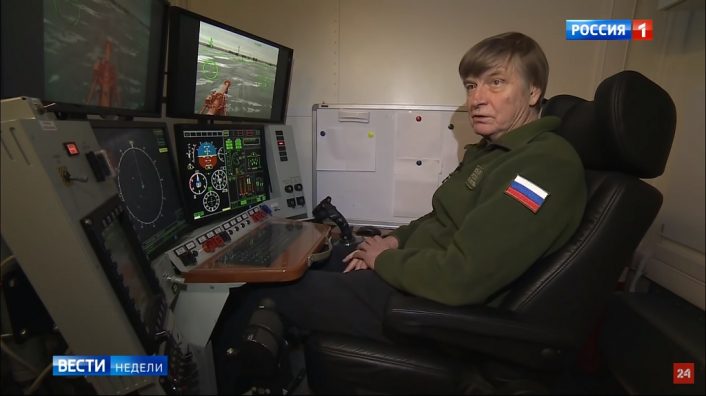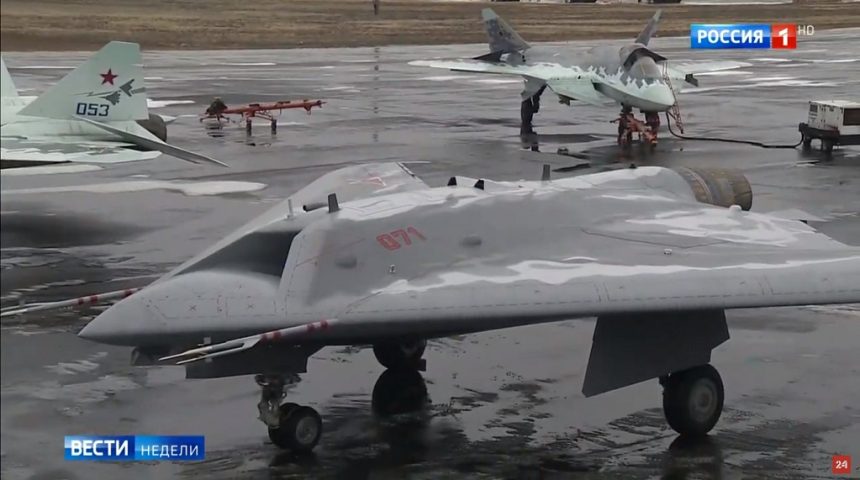For the first time the Sukhoi S-70 Okhotnik UCAV’s Chief Designer and the ground control station were introduced to journalists after years of strict secrecy.
Russia’s state-owned Channel One television aired a report about the Russian Aerospace Forces’ Unmanned Aerial Vehicles (UAVs) last week. Among the different systems, it showed the Sukhoi S-70 Okhotnik or “Hunter-B” UCAV in what should be the first time that civilian journalists were allowed to film it up close.
Until now, the Okhotnik was kept under strict secrecy and few details were available, with just a few photos and videos released by the Russian Ministry of Defense. During the show, some new details about the drone were revealed, including a glimpse to the ground control station. Also, for the first time, the Chief Designer of the UCAV, Sergey Bibikov, appeared publicly, to talk with the journalists about the ambitious project.
Dmitry Kiselyov’s program had a long segment about Russian UAVs and UCAVs, starting with a close look at the S-70 Okhotnik UCAV.https://t.co/P3uEaKv5KS pic.twitter.com/xIPchxU1cw
— Rob Lee (@RALee85) February 21, 2021
The S-70, which flew for the first time on Aug. 3, 2019, was developed by Sukhoi in about three years, according to the report. However, this differs from other sources which stated that the drone was in development at least since 2011, when the first funds were allocated to the Sukhoi UCAV program by the MoD. Moreover, the S-70 is based on a 2005 prototype by Mikoyan-Gurevich (MiG) called the “Skat”, whose mock-up was first showcased at the MAKS 2007 international air show.
According to Bibikov, Okhotnik is the first Russian drone entirely built using low observability concepts and special composite materials after the country managed to make-up, at least in part, for its technological backwardness in the advanced aviation industry. This backwardness is also the reason why Russia is years behind the United States and China in the 5th gen aircraft arena and UAVs, with the first serial production Su-57 5th gen. aircraft just delivered and armed drones being a recent introduction in the RuAF.
The Okhotnik seems to be largely built with a composite material that was specially developed for this purpose, although it may be also related to the composite materials used by the Sukhoi Su-57 “Felon”. The S-70 is, however, still pretty heavy for its size, weighting “nearly 20 tons” (almost twice the weight of a MiG-29 or an F-16 and four time the weight of similar drones like the X-47B or the nEUROn) for a wingspan of about 20 meters and a length of about 14 meters.

Currently, only one flying prototype has been built. Earlier last month it was reported that three additional prototypes might be under construction at the Novosibirsk Chkalov Aviation Plant. According to RIA Novosti, the second prototype will be an improved variant of the first one, built upon the lessons learned during the flight test campaign, while the other two will be similar to the production version. Reportedly, the production version’s AL-41F engine (non-afterburning variant) will receive a flat nozzle to further reduce their thermal and radar signature, instead of the standard one which is used on the first prototype, similarly to other flying wing drones.
1/ A RIA Novosti source says that 3 more prototypes of the Sukhoi S-70 #UCAV (#Okhotnik program) are being built at the Novosibirsk Aviation Plant & should join flight tests in 2022-2024.https://t.co/LR0ezGM4Cy
— Guy Plopsky (@GuyPlopsky) February 12, 2021
The Okhotnik, at this stage, is still a Remotely Piloted Aircraft (RPA) and this was confirmed also when the ground control station was seen for the first time in last week’s report. The control station is somewhat different from the older one used by drones like the MQ-9 Reaper, but reminiscent of the more recent Block 30 and 50 control stations.
As we could see in the video, four big screens are in front of the pilot, of which two displaying the feeds from external cameras and the other two displaying the aircraft’s info, with a format similar to what can be seen in the Multi-Function Displays (MFD) used by Russian aircraft. Also, a lone MFD, various switches and HOTAS (Hands On Throttle And Stick) controls similar to the most recent Sukhoi aircraft complete the equipment of the ground control station.
The S-70 is piloted by test pilot Yevgeny Frolov, Hero of the Russian Federation, because “such an expensive and unique system would not be trusted to anyone else”. During the interview, he said that the current manual controls are practically identical to the ones found in manned aircraft, but the goal is to have Okhotnik become fully autonomous with no manual controls at all. According to Frolov, the drone will be able to attack targets using its own weapons and sensors once they get assigned by a manned aircraft like the Su-57.
Some sources claimed that the Okhotnik was also tested in Syria, along with other Russian armed drones. However, while there are photos and videos confirming that the Orion UAV was deployed at Tiyas Air Base in Syria, flying combat patrols and employing weapons, there is no evidence of the S-70 being there. Moreover, the supposed deployment would have taken place at least two years ago, while only recently the first weapon testing of the Okhotnik were disclosed by Russian sources.
At the end of the Okhotnik’s report, Bibikov also claimed that the drone is unique in the world and that nobody, not even the United States, are developing a similar system, as their many UAV programs have different purpose than the S-70. According to the report, the MoD is planning to introduce into service the drone in about two years.
A couple of weeks ago it was reported that the Russian MoD wants to integrate the Okhotnik with the Su-57 squadrons, assuming that 2 to 3 Su-57 squadrons would have a single UCAV unity assigned to them and establishing a manned-unmanned teaming (MUM/T) scheme. The program aims to create a data link between the manned and unmanned aircraft, with the Su-57 pilots able to assign tasks to the UCAVs, providing a further demonstration that the S-70 could get the role of a “Loyal Wingman” for the Su-57 Felon.









